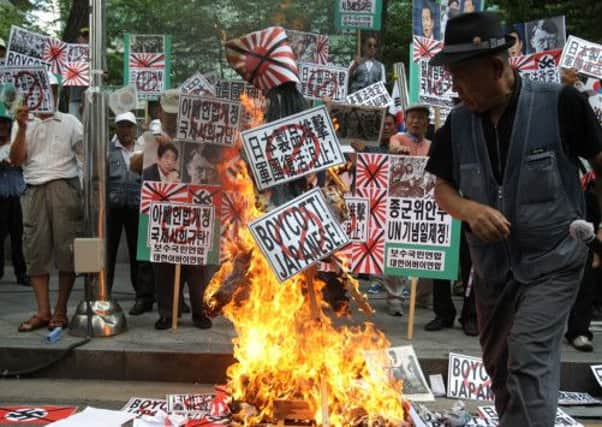Fury at Japan war-anniversary visit to Tokyo shrine


The Cabinet members paid homage at Yasukuni shrine, though prime minister Shinzo Abe, whose nationalist stance has worried regional neighbours, did not attend. Instead one of his aides presented a ritual offering bought with his own money. He also laid flowers at a national cemetery dedicated to more than 352,000 unidentified war victims.
His two Cabinet colleagues, wearing morning suits, did pay their respects at the shrine yesterday, prompting China to summon the Japanese ambassador in Beijing to protest and provoking angry scenes outside the Japanese embassy in South Korean capital, Seoul.
Advertisement
Hide AdAdvertisement
Hide AdA shrine sacred to the Shinto religion, Yasukuni evokes bitter memories across Asia of Japan’s wartime aggression. It honours 2.5 million Japanese war dead, including war criminals such as Hideki Tojo, the wartime premier executed in 1948.
Japan has repeatedly apologised for its wartime actions, but the shrine remains a flashpoint nearly 70 years after Emperor Hirohito issued his proclamation surrendering to Allied forces on 15 August, 1945.
Mr Abe joined Emperor Akihito at a ceremony at a Tokyo indoor arena where they bowed before a backdrop of white and yellow chrysanthemums in paying respects for the war dead.
“I pray for world peace and our country’s further prosperity,” the emperor said.
Mr Abe has said he regrets not visiting Yasukuni on the anniversary during his first, one-year term in 2006-7.
When asked if he would go this year, he said: “Since it would become a political and diplomatic problem, I cannot tell you that.”
Past opinion polls have shown most of those asked support visits to the shrine by Japanese leaders.
Mr Abe’s support for revising Japan’s pacifist constitution and raising the profile of its military are compounding the unease at a time of rising tensions over a cluster of uninhabited islands in the East China Sea claimed by Japan and China.
Advertisement
Hide AdAdvertisement
Hide AdHackles rose also at the unveiling earlier this month of Japan’s biggest warship since the end of the war. The Izumo, a flat-top destroyer, shares the same name as a warship in the Imperial Navy destroyed in an American attack in 1945.
“We call upon the Japanese side to honour their commitment to admit and reflect upon their history of invasion, act with care on relevant questions, and through concrete actions, win the trust of the people of Asian victim nations and international society,” Chinese foreign ministry spokesman Hong Lei said on the ministry’s website. He added that vice-foreign minister Liu Zhenmin had summoned Japanese ambassador Masato Kitera, lodged “solemn representations” and expressed “strong protest and severe condemnation.”
A retired Chinese general was blunter. “Can you imagine what the world would think of Germany if they paid homage to Hitler?” Major General Luo Yuan wrote in the Global Times.
Despite its apparent tranquility, Yasukuni remains a focus of nationalist pride and is closely associated with the monarchy, although royal family members have rarely visited. The heir apparent visited in 1975. He became emperor in 1989.
Yasukuni was created in 1869 to honour 3,588 loyalists who died the year before, when imperial forces overthrew centuries of feudal rule. Standing sentry is the bronze statue of the founder of Japan’s modern army.
Its museum unapologetically recounts Japan’s military exploits over the past 150 years, including its occupation of much of Asia in the early 20th century.